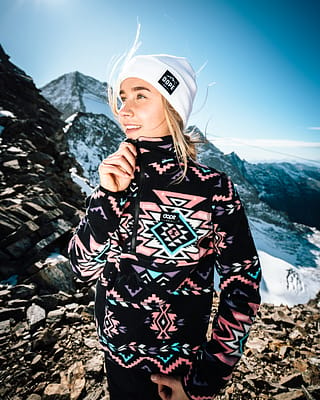All you need to know about base layers
Base layers are an essential piece of mountain wear, and below, we dig into exactly why that is and why you should always have one on hand for every snowy adventure.

When it comes to base layers, things aren’t always cut and dry. It can be difficult at first to wrap your head around the necessity of a base layer, and then to understand the mechanics of them, too. Especially when some seem to clock in at more than a ski jacket in pricing! There’s a lot of science in these seemingly simple garments however, and depending on weight, material, and construction, they can keep you warm and perform in a bunch of different ways.
Most schools of thought divide base layers into two categories — synthetic and natural. While both have their merits, they perform differently, and are better for different activities. Synthetics don’t absorb as much moisture, and so are great for more strenuous activities where you sweat more. They help to ‘wick’ that moisture from the body thanks to their high breathability. While wool and natural fibres are great insulators and perfect for colder days. But, there’s a lot more nuance at work here than just the fabric, so read on to answer some of the most common questions about base layers!

Choosing the right companions for your base layers
Base layers may seem straightforward, but much like their counterparts - ski jackets - there's much to consider. The material, weight, and construction of these garments balance warmth and comfort, boosting your experience on the snowy slopes.
What kind of material should a ski base layer be made out of?
Your base layer needs to be made out of a material that leads moisture away from your skin. Polyester, nylon, polypropylene or blended synthetic fabrics are some common ones that do the trick. Merino wool is the most common material that is not synthetic that still does a good job.
Watch out for silk, it might feel nice against your skin. But performance wise it can not hold up against synthetic or merino wool.
How often should you wash your ski base layer?
This is individual and depends a little bit on the type of base layer and how often you use it. But, a good rule of thumb, when it smells bad it is probably time to wash it. Just read up on the washing instructions.
Make sure to let it dry every time you get it sweaty or use it, that way it will keep alive longer.
What is a base layer shirt?
A base layer shirt is your top. The most common is to buy a base layer that is consisting of two parts. One base layer shirt and a pair of base layer pants. These two together make your base layer.
What are base layer pants?
Your base layer pants are your second part of the base layer. Just like it sounds, it is a pair of pants. Together with your base layer shirt, it makes a complete base layer.

What is the warmest base layer clothing?
The thickest base layer is also usually the warmest one. Pretty simple. But, with the small detail that the warmest one might not actually be the one that keeps you the warmest.
The base layer also needs to breathe and lead sweat away from your body. So be sure to read the answer to question #1 before choosing. What material should a base layer be made out of?
What to wear over a base layer?
Over your base layer comes your second or mid layer. That is the layer that should add warmth. The insulation layer. Polyester fleece, down insulated or synthetically insulated products, is what you should look for here.
What is the difference between compression base layer and mid layer?
A compression base layer fits tightly against the skin with compression fit garments that give a bit of muscle support and increased blood flow. It should not fit so tight that it restricts freedom of movement. A mid layer base does not offer any compression.
What does a base layer entail for hiking?
A base layer for hiking and snow activity is pretty much the same thing. The difference can though be in terms of warmth. If you go for a warmer hike, you might want a base layer that only leads moist away without adding too much warmth. A thinner layer might be your best choice then.

Can you wear two base layers?
Simply, yes. Wearing two base layers can be an effective and flexible part of your layering. If you are out in very cold conditions. Wearing two base layers can be really helpful. And if you get to warm, removing one of the base layers is easy. So give it a go the next time you’re out on really cold adventures.
What base layer should be used for skiing?
There is not one base layer that is the best one, but there is one that is the best for you. If you know what climates and what kind of skiing you are doing, that can help you to choose the thickness of your base layer. But for most, a mid-thick synthetic base layer is the best and most flexible bet.
What is the best base layer for snowboarding?
Just like with skiing above, there is not one best base layer. But for most, a synthetic mid-thick base layer would be the best and most flexible bet.
Related Reading:
